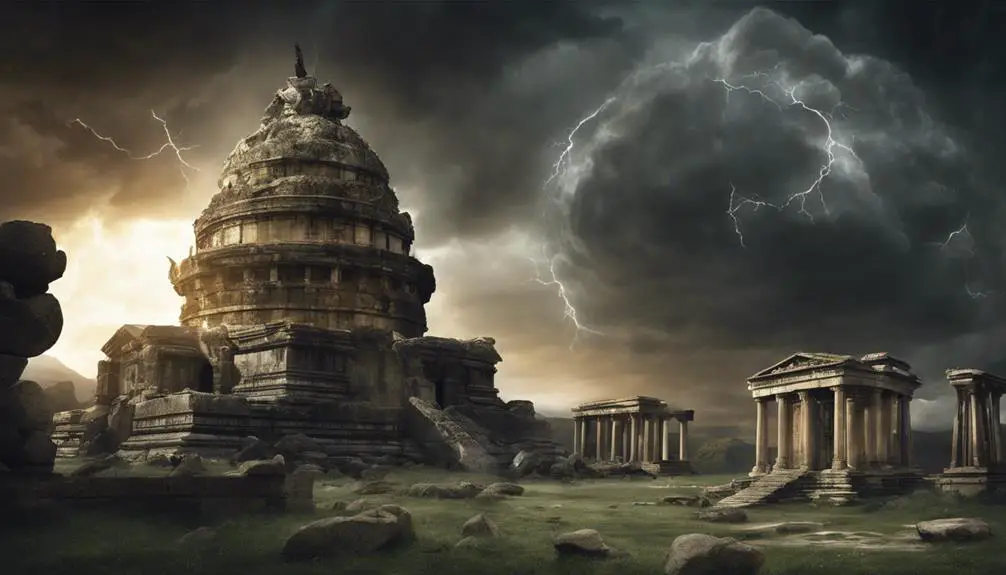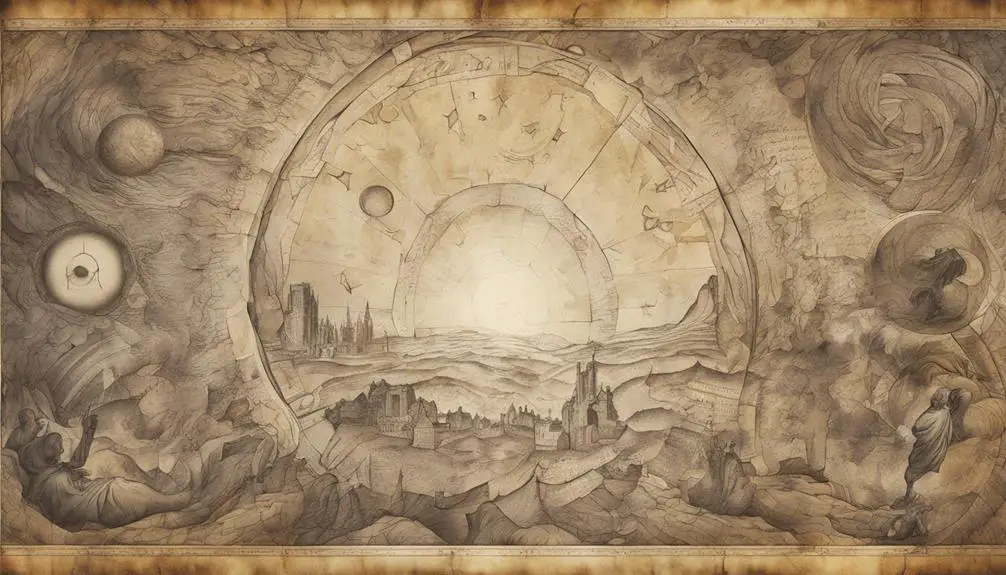Unearth the Biblical prophecy about the world's end through verses like Revelation 21:1, leaving you intrigued about the divine vision of a new heaven and earth.

What Bible Verse Talks About the World Ending
In the delicate dance of life, have you ever pondered the final curtain? The Bible, a profound source of wisdom and guidance, does hint towards the earth's ultimate destiny.
Let's explore verses like Revelation 21:1, which speaks of a 'new heaven and a new earth', or the prophetic words of Matthew 24:14. Yet, as you wade into these deep waters, remember that interpretations vary and context is key.
Intrigued? Let's embark on this enlightening journey together, unveiling the Biblical perspective on the end of the world.
Key Takeaways
- The Book of Revelations and Matthew 24 provide detailed prophecies about the end of the world and Christ's return.
- Peter's vision in 2 Peter 3:10-13 depicts a cataclysmic ending and the promise of a new world.
- Allegorical language and symbolism, like the number seven in Revelations, are essential in understanding end-time prophecies.
- Interpretation of these prophecies requires cultural context and awareness to avoid anachronistic misunderstandings.
Apocalyptic Predictions in Revelations

Delving into the book of Revelations, you'll find it rife with apocalyptic predictions which provide profound insights into the biblical prophecy of the world ending. The vivid allegorical language used throughout the book paints an ominous picture of the end times. It's a complex, multi-layered narrative that offers more than just a simple prediction.
You'll notice the recurrent theme of the number seven: seven seals, seven trumpets, seven bowls. These elements, when sequentially opened, blown, and poured out, respectively, each trigger catastrophic events. They symbolize God's judgment and wrath, leading up to the final destruction and purification of the world.
The book also mentions the appearance of the Antichrist, a deceptive global leader who'll cause widespread chaos and persecution. In addition, you'll find the concept of the Rapture, where believers are taken up to heaven, while non-believers remain to face tribulation.
In its entirety, the book of Revelations provides a prophetic roadmap of the world's end. Despite its complexity and symbolic language, it serves as a crucial piece of the biblical end-time prophecy puzzle. Remember, however, that interpretation requires careful study and reflection, considering the book's historical and cultural context.
Matthew's End-Time Prophecies

Turning our attention to the Gospel of Matthew, you'll find it teeming with end-time prophecies that further illuminate the biblical narrative of the world's culmination. Matthew 24, also known as the Olivet Discourse, is particularly significant. Here, Jesus delivers prophetic sermons about the end times, covering topics from the destruction of the temple to the signs of His return.
Take a look at the table below to get a detailed understanding of some of these prophecies.
Matthew 24 Verses |
Prophecy Description |
|---|---|
Verses 1-2 |
Prediction of the temple's destruction |
Verses 4-14 |
Signs of the end times, including false prophets, wars, and the spread of the Gospel |
Verses 15-28 |
The "Abomination of Desolation" and the Great Tribulation |
Verses 29-31 |
Signs in the heavens and the second coming of Christ |
These prophecies, while open to various interpretations, offer profound insights into the eschatological beliefs of early Christian communities. As you delve deeper, you'll see how Matthew's Gospel reflects a sense of urgency about the world's end, intertwining it with moral teachings and the hope of Christ's return.
Peter's Vision of the World's End

Transitioning from Matthew's prophetic visions, we now explore Peter's apocalyptic foresight, which offers a distinct perspective on the world's end in the New Testament. Peter's vision is chiefly encapsulated in his second epistle, particularly in 2 Peter 3:10-13.
In these verses, Peter paints a vivid picture of the world's end. He describes it as the 'Day of the Lord,' a cataclysmic event characterized by suddenness and intense heat. Peter portrays the heavens passing away 'with a roar,' the elements being destroyed by fire, and the earth and its works exposed. Indeed, Peter's vision doesn't sugarcoat the reality of the world's end. It's intense, it's fiery, and it's sudden.
Yet, Peter's vision isn't all doom and gloom. Amid the fiery end, Peter offers hope. He speaks of a new heaven and a new earth where righteousness dwells. This duality is paramount to understanding Peter's eschatological perspective. The end, though catastrophic, is also the birth of a new, righteous world. Thus, Peter's vision of the world's end is both a warning and an invitation for righteousness.
Old Testament Prophecies

Peering into the wisdom of the Old Testament, you'll discover a trove of prophecies that shed light on the concept of the world's end. These ancient texts offer profound insights into the apocalyptic narrative, each with its unique perspective.
The Book of Isaiah, for instance, speaks of a day when the heavens will vanish like smoke, the earth will wear out like a garment, and its inhabitants will die like flies (Isaiah 51:6). It's a grim picture of destruction, and yet the prophet assures that God's salvation will last forever.
Then you have Daniel's prophecy of the 'time of the end' (Daniel 12:4), where knowledge will increase and people will be purified, made spotless and refined. This prophecy, while nuanced, indicates a period of intense tribulation followed by a purer existence.
In the Book of Ezekiel, you'll find references to an end time when God will show His greatness and holiness, making Himself known in the sight of many nations (Ezekiel 38:23). This suggests a divine manifestation that's earth-shattering in its grandeur.
These prophecies, while cryptic, provide a valuable lens through which you can examine the biblical concept of the world's end.
Interpreting the Symbolism

To fully comprehend these apocalyptic prophecies, you'll need to delve into the rich symbolism that permeates biblical texts. Symbolism is central to biblical interpretation. It's not just about understanding words as literal descriptions, but discerning the deeper, metaphorical meanings they carry.
Consider, for example, the Book of Revelation, overflowing with symbolic language. Beasts with multiple heads, stars falling from the sky, and a woman clothed with the sun—these aren't literal events, but symbolic representations. The beasts might symbolize empires or rulers, the falling stars could represent divine judgment, and the sun-clothed woman might denote the Church or Israel.
As you interpret these symbols, you'll need to be aware of the original audience and their cultural context. What did these symbols mean to them? It's important to avoid anachronistic interpretations—that is, reading our modern meanings into ancient symbols.
Conclusion
In conclusion, you've explored the apocalyptic predictions in Revelations, Matthew's end-time prophecies, Peter's vision of the world's end, and Old Testament prophecies. You've delved into interpreting the symbolism in these verses.
Remember, these texts invite much interpretation and debate. They remind us that the Bible's teachings, especially regarding the world's end, are complex and multifaceted.
Ultimately, your understanding will be shaped by your faith, personal beliefs, and the broader context of biblical teachings.



Sign up